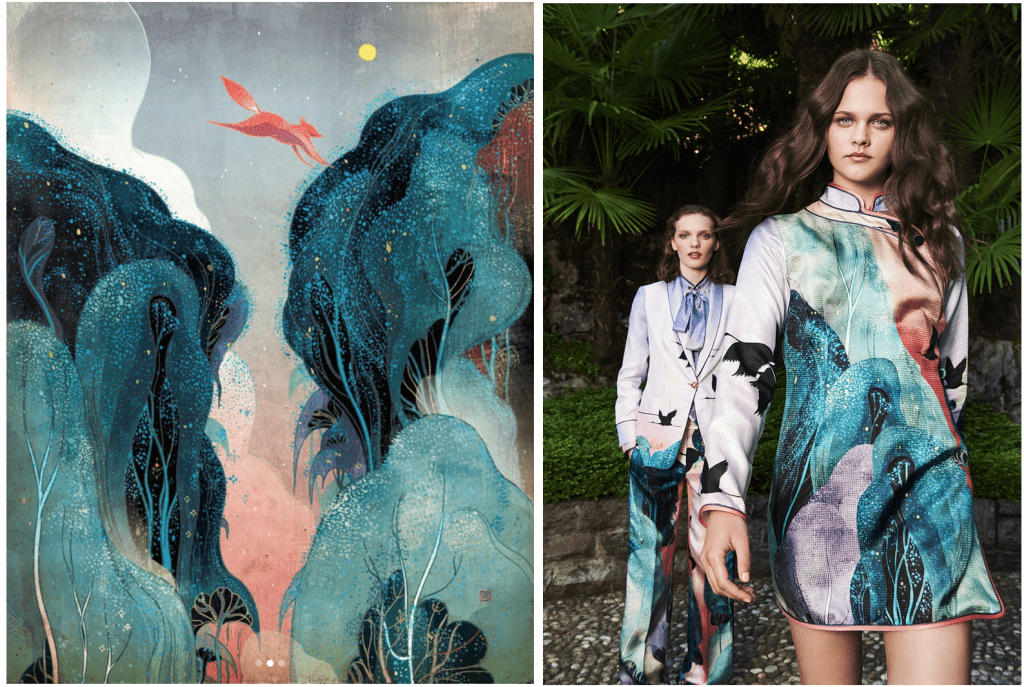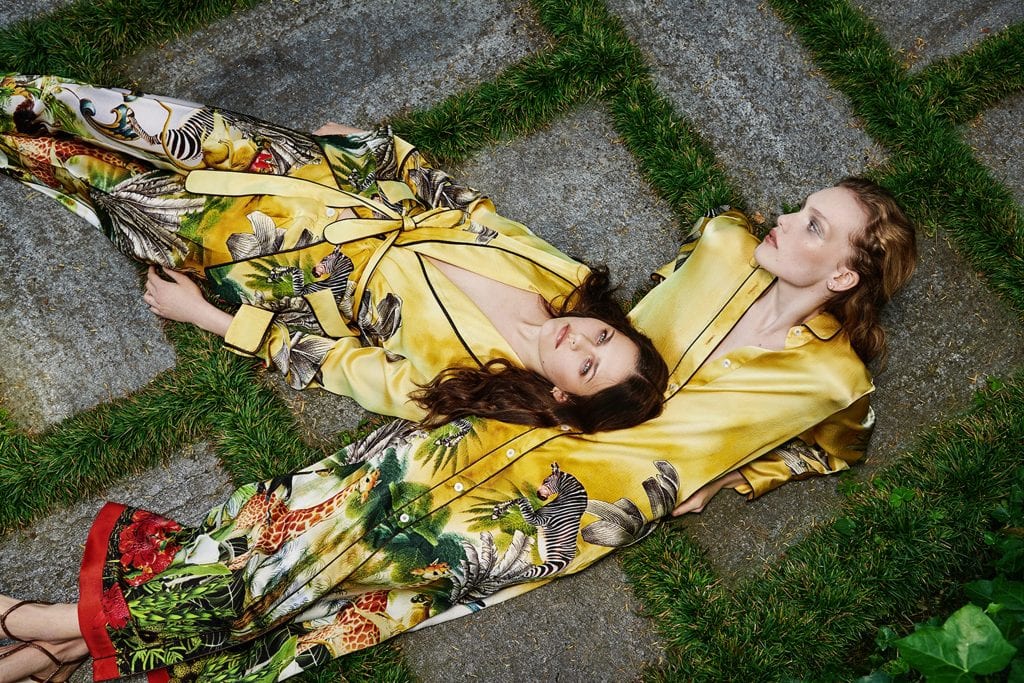Italian “pajama dressing” brand For Restless Sleepers has been receiving rave reviews from Vogue as of late, with the fashion publication citing designer Francesca Ruffini’s “sumptuous prints” and the addition of “versatile separates infused with a flair for decadence” – to its initial offering of upscale pajama-inspired pieces – as central to the burgeoning success of the four-year old brand. Having landed stockists like Farfetch and Moda Operandi, and found fans in its “opulent and exotic” wares, For Restless Sleepers has been on the up-and-up. Now it is coming under fire.
A celebrated Hong Kong-born, Los Angeles-based artist is calling foul on Ruffini’s burgeoning brand for allegedly jacking one of her prints and using it in one of its latest collections. In an Instagram post on Sunday, Victo Ngai says that she does “not recall giving consent to” For Restless Sleepers to use her art in its Resort 2020 collection, and points to an airy suit and silky mini-dress from the brand’s recent lookbook as examples of “shameless” intellectual property theft.
In short, Ngai alleges that the print that appears on For Restless Sleepers’ garments is the direct result of a case of copy-and-paste.
Given the similarity at issue (and it is, in fact, quite striking), Ngai’s side-by-side post is gaining a quite a bit of traction among Instagram users, with many urging the young artist to haul the fashion brand into court, presumably on copyright infringement grounds, as copyright law may protect original prints, including ones that appear on garments.
As for whether this would be the “slam dunk” win for Ngai that many social media users are suggesting, that unfortunately does not seem to be the case, unless Ms. Ngai maintains a federally registered copyright for the specific print at issue. Unlike in the past, when having a copyright registration was not a prerequisite to filing a copyright infringement lawsuit, the law changed in March 2019 when the Supreme Court determined in the Fourth Estate Public Benefit Corp. v. Wall-Street.com, LLC case that a plaintiff must obtain registration of a copyright in a work before filing a lawsuit on the basis of infringement of that work.

Based on the Copyright Office’s current records, it does not appear as though Ngai – who landed on Forbes’ 30 Under 30 Arts & Style list in 2014 at age 26 and boasts a roster of big-name clients that range from the New York Times and Dreamworks to Apple and American Express – has registered the print, thereby, taking a potential copyright action off of the table, for now at least. (It is possible that she could file and receive a registration and sue after the fact).
However, just because Ngai does not have legal recourse, that does not mean she is entirely without options. In recent years, social media call-outs have become a widely-used remedy for brands that do not have a basis for litigation – either because of a lack of substantial similarity (the core inquiry in a copyright infringement matter) or because they fall short when it comes to statutory conditions, such as copyright registrations – and/or for brands that lack the funds to take formal legal action.
It is worth noting, of course, that copyright call-outs on Instagram rarely produce to the same results as a successful court battle; for instance, it is relatively uncommon for these social media squabbles to lead to formal settlements between the parties that include monetary damages paid to the individual whose work has allegedly been infringed, as would follow from a finding of infringement in court. As professors Amy Adler and Jeanne Fromer state in their 2019 paper, “Taking Intellectual Property into Their Own Hands,” instead of providing remedies that mirror those available to successful plaintiffs in copyright cases, such “extralegal uses of shaming” that can be found on Instagram provide “a quick, cheap and reliable remedy with incomplete relief.”
In short: comparing the remedies that can be derived from successful copyright litigation to those associated with even some of the most virally-spread copyright call-outs is a bit like comparing apples to oranges.
That is not to say that these efforts are ultimately devoid of any results, though. One of the key things to be gained from such a scenario is the strong consumer awareness/perception element that is often associated with these copycat call-outs. This is clearly demonstrated in the comments on Ngai’s post, many of which swear off For Restless Sleepers and its products, while others call on the Ruffini and her brand to make the situation right for Ngai. This goes to Adler and Fromer’s points that “although companies have always been sensitive to reputation, social media has changed the game, [which means that] individual customers now have the capacity to wage shaming campaigns that can bring a brand to its knees in a matter of hours,” or which have the capacity to blow over in a matter of hours given the break-neck pace of the media.
All the while, there is a often sense of positive brand awareness-building and of community building in connection with the alleged victim of the copying, and awhich could ultimately have a positive impact on his/her bottom line.
It is not yet clear which of those possibilities will play out here, but either way, the hypothetical case provides some noteworthy insights into the reality of the post-Fourth Estate copyright landscape and the alternative remedies available in the age of Instagram.
In a statement to TFL, Ruffini said, “I am mortified by what happened and truly had no idea the image belonged to Victo Ngai. I found it on a photographic archive of images, it looked very vintage to me and [so, I did not] investigate the origins further, and [for] this I’m both ashamed and sorry.” She further stated that “this accident must serve as a lesson both to me and my brand but also to other brands, and I will most certainly reach out to the artist to try and make up to my mistake, in a way that will make her feel comfortable with the situation and be constructive towards this mistake,” noting that she has already “withdrawn the pieces from my website as a sign of respect.”











